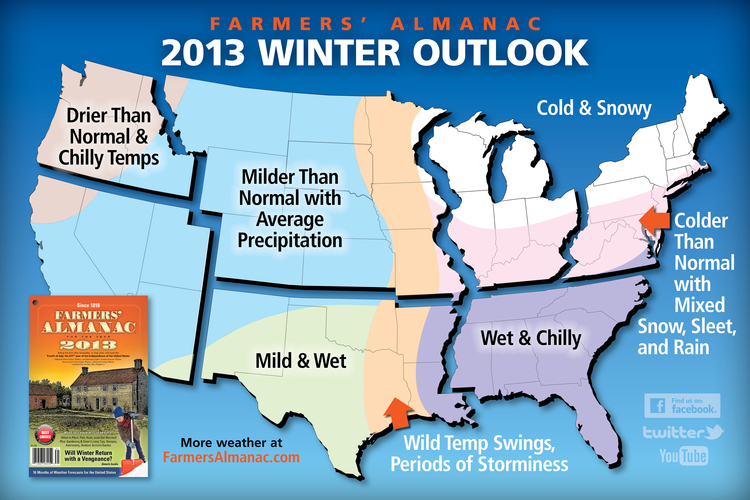
Photo/Illustration: Courtesy of The Farmers’ Almanac

Photo/Illustration: Courtesy of The Farmers’ Almanac

Photo/Illustration: Courtesy of The Farmers’ Almanac

Photo/Illustration: Courtesy of The Farmers’ Almanac

Photo/Illustration: Courtesy of The Farmers’ Almanac

Photo/Illustration: Courtesy of The Farmers’ Almanac
I never get my fortune told, disregard tea leaves at the bottom of my teacup, and will myself to ignore the lines on the palms of my hands. But for some reason, I’m always inclined to flip through the quaint-looking Farmers’ Almanac, a weather conditions forecast publication in print since 1818. After years of persusing its pages, I decided to ask the folks at The Almanac itself how they work. Managing editor Sandi Duncan responds:
How does the Farmer’s Almanac make its weather predictions?
Duncan: The Farmers’ Almanac predictions are based on a very specific and reliable formula that remains secret to all but a few select Almanac associates. It is based on a formulate that dates back to 1818 that looks at tides, astronomical events, and sun spots. It also closely monitors the changing distance of the Moon relative to Earth, as well certain lunar cycles. And lastly, we follow a list of rules (the first editor of the Farmers’ Almanac, David Young called them his “weather canon”) which specifies certain weather patterns based on natural cycles. That canon might be regarded as our famous and closely guarded “secret formula” that dates back for nearly 200-years; we believe that, augmented with our more recent studies of solar activity and lunar cycles, we have been able to refine and improve our forecasts.
So you use none of the modern technologies utilized by today’s meteorologists, like IBM’s Bluefire computer in Colorado?
Duncan: We don’t use computers, satellite, or modern day radar tracking systems. We find our formula to be a proven way to predict long-range outlooks. Over the years there have been only seven weather prognosticators who have taken the formula or “weather canon” and added some observations and changes to the original rules that were set back in 1818.
Is Generation Y buying into the almanac?
Duncan: There seems to be a growing trend to get back to the basics, back to growing your own food and eating and living more naturally, especially with the younger generation. This seems to be fueling the interest in the Almanac with Gen Y readers, as we have always offered tips, articles and information on ways to live life in a more simple, organic way. Plus, now that we have entered the digital age with social media sites and ebooks, we are offering our information in formats that Gen Y demands. So yes, the Farmers’ Almanac continues to be relevant and popular among all generations.
What advice would you give gardeners going into the fall season?
Duncan: Fall doesn’t mean the end the gardening season, but it does mean that you need to keep an eye on the weather, especially if you live in northern sections of the country. We list average frost days in the Farmers’ Almanac and online, as well as an article on how you yourself may be able to predict a coming frost.
Going into next year?
Duncan: According to the 2013 Farmers’ Almanac, winter will be returning to normalcy on the East and still be quite mild in western portions of the country. Precipitation looks average to above-average in some areas, which should help a little in areas that were plagued with drought this year. This should work well for gardeners and farmers.
I’d be interested in hearing any experiences our readers have had with The Farmers’ Almanac. Leave a comment below.

















Comments
Log in or create an account to post a comment.
Sign up Log in